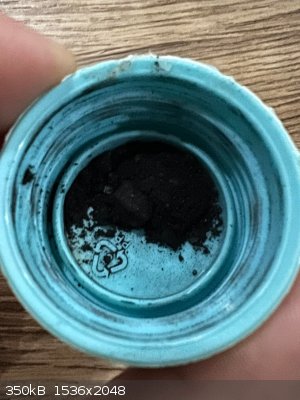vano
National Hazard
   
Posts: 661
Registered: 22-3-2019
Location: Georgia
Member Is Offline
|
|
Question about 3,3'-Diaminobenzidine
Hello, I had a jar of 3,3'-Diaminobenzidine, when I opened it it had black color and ammonia smell, what is the easiest way to make some pure
3,3'-Diaminobenzidine? just the reagent every photo which I saw on the internet had no black color.
 
|
|
|
Boffis
International Hazard
    
Posts: 1840
Registered: 1-5-2011
Member Is Offline
Mood: No Mood
|
|
Hi Vano, I have a small phial of this selenium reagent too and like yours it is old and now as black as coal. I don't have much c5g, so I decided to
try "recovery" methods on two other compounds that I have that are similar, 2-nitro-1,4-phenylenediamine and N,N-dimethyl-1,4-phenylenediamine
(4-amino-dimethylaniline). Both are also as black as coal and now resemble charcoal. They are all very old >50 years!!
So far I have had no success with the 2-nitro compound but I have had fair success with the dimethyl-phenylenediamine. I found that if I dissolve it
in dilute HCl and treat it hot with a little sodium metabisulphite solid and then Zn dust until the later dissolves with the liberation of hydrogen.
The dark violet solution is then treated with charcoal and acid washed kieselguhr and filtered. If the solution is strong enough or excess conc HCl is
added the hydrochloride crystallises out as light purple blades. which are fairly pure but discoloured still. I have found that it is better to ppt
the free base directly, filter, wash with water until acid free and then dissolve in acetic acid/acetic anhydride mixture and convert to the
4-dimethylamino-acetanilide which is stable and can be recrystallised until it is pure white from any simple alcohol. Note that when the acetylating
mixture is diluted there is no acetanilide ppt immediately so strong NaOH solution needs to be added to neutralise part (but only part of) the acetic
acid. A copious lilac coloured ppt then forms, chill to freezing before filtering to improve the yield and recrystallised from methanol, ethanol or
isopropanol. One recrystallisation with charcoal treatment usually gives pearly, very pale lilac plates of the acetanilide but these are pure enough
for my purposes.
I am still working on the 2-nitro-phenylene diamine, it is complicated by the reducible nature of the nitro group and the possibility of complex side
reaction with bisulphite ion (ie Piria's reaction) so I tried total reduction with zinc or iron powder to the 1,2,4-triamine but The solution remains
very dark coloured and I couldn't separate the triamine from the metal residues but the amine is so prone to oxidation in neutral or basic conditions.
I am not sur eif these notes are going to be of help but they may give you some ideas. Let us know how you get on as I too have so black
diaminobenzidine.
|
|
|
vano
National Hazard
   
Posts: 661
Registered: 22-3-2019
Location: Georgia
Member Is Offline
|
|
thank you for the ideas Boffis!
I tried to use it, I wanted to make a binuclear ligand with 3,3'-Diaminobenzidine and dione(oxidized 1,10-phenanthroline). But nothing came out. The
fact is that the reagent is no longer what is written on the jar.
the sad fact is that my reagent isn't very old, it's a fluka chemika reagent maybe 10 years old, also it was unopened, I opened it a few months ago.
I wanted europium complex with the final compound and any acetylacetone derivative. I didn't even think of using it for anything else, I just wanted
to make this compound:

[Edited on 16-9-2022 by vano]
|
|
|
Lionel Spanner
Hazard to Others
  
Posts: 163
Registered: 14-12-2021
Location: near Barnsley, UK
Member Is Offline
|
|
I wouldn't be surprised if it contained oxidative polymerisation products. Phenylenediamines are prone to oxidation over time, and produce very
dark-coloured polymeric materials as a result - this is why they are used in hair dyes.
|
|
|